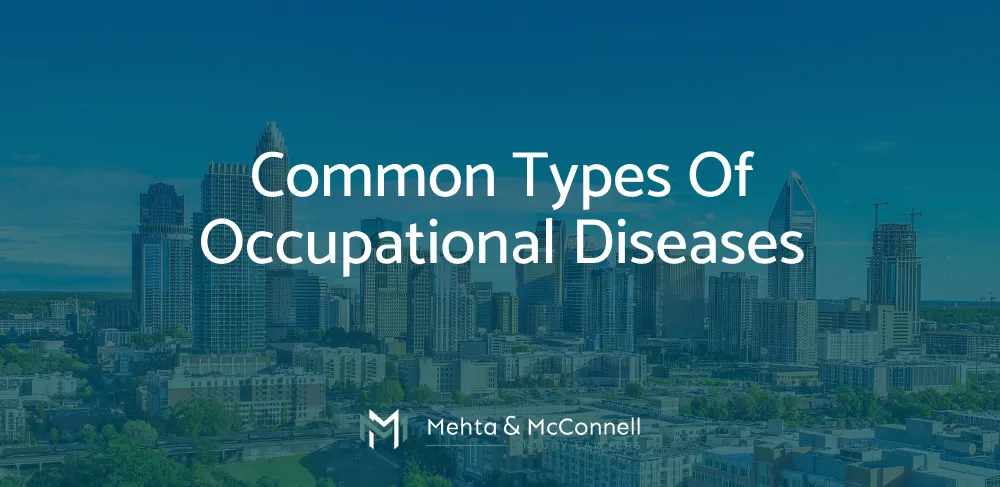 Workers' Compensation
Workers' Compensation
Employees are right to expect to work in a safe and healthy environment. In fact, employers have a responsibility to provide their employees with a safe workplace.
Unfortunately, many people work in environments that expose them to harmful substances or unsafe conditions that can lead to several common types of occupational diseases.
These illnesses can range from mild to severe and can even be fatal in some cases. Occupational diseases can also significantly impact a person’s long-term health and quality of life.
In North Carolina, workers who suffer from occupational diseases may be eligible for workers’ compensation benefits.
If you or a loved one suffers from an occupational illness, it is important to seek legal assistance to help you pursue compensation.
At Mehta & McConnell, PLLC, we can help you file a workers’ compensation claim and help you pursue the settlement you need to heal.
Our compassionate advocates have over 30 years of combined legal experience helping clients who have suffered employment-related illnesses fight for the compensation they deserve.
What Is an Occupational Illness?
Occupational diseases are illnesses caused or worsened by work environments, including asthma, contact dermatitis, and musculoskeletal disorders.
Workplace absenteeism increases due to diseases like occupational asthma, avian influenza, HIV/AIDS, hepatitis B and C, occupational cancer, cardiovascular disease, Valley Fever, and musculoskeletal disorders caused by poor ergonomics.
OSHA defines a “workplace” as “the establishment and other locations where one or more employees are working or are present as a condition of their employment.”
A person’s work environment includes physical locations as well as the use of any equipment or materials during their work.
Furthermore, a disease only becomes an occupational disease when it is more prevalent in a specific body of workers than in the general population or other worker populations.
In other words, the condition must relate to the work you have done.
For instance, if a chemist contracts anthrax from a specimen after a tube breaks, that illness counts as an occupational disease because it is related to the nature of the chemist’s employment and job tasks.
Conversely, if the same worker can easily encounter a specific disease outside the workplace—for instance, the flu—catching it at work does not make it an occupational disease.
What Are the Most Common Types of Occupation-Related Diseases?
North Carolina’s Workers’ Compensation Act lists specific types of occupational diseases that can make workers eligible for compensation. So, what are examples of occupational diseases?
The occupational diseases list includes conditions caused by exposure to workplace hazards, such as asbestosis, silicosis, noise-induced hearing loss, and occupational dermatitis.
But while there are many kinds of occupational diseases, a handful of occupational diseases are more common than others. Some of the most common occupational diseases are discussed below.
Global Contact Form
1. Respiratory Diseases
Respiratory illness is one of, if not the most common, type of occupational disease.
Workers in industries such as mining, construction, and manufacturing are at a higher risk of developing respiratory diseases because of their exposure to harmful substances like asbestos, silica, and coal dust.
These substances can damage the lungs and lead to chronic conditions like asbestosis, silicosis, and chronic obstructive pulmonary disease.
These chronic conditions can cause difficulty breathing, coughing, chest pain, and fatigue.
2. Skin Diseases
Workers in industries such as healthcare, cleaning, and construction are at a higher risk of developing skin diseases because of their exposure to harmful chemicals, irritants, and allergens.
This regular exposure can cause contact dermatitis, occupational acne, and skin cancer.
Contact dermatitis is a skin rash caused by exposure to irritants or allergens, while occupational acne is a skin condition caused by exposure to oils, greases, and other chemicals.
Sunlight, chemicals, and radiation exposure can cause skin cancer. All these diseases can cause skin damage and internal damage.
3. Chemical Poisoning
Occupational chemical poisoning is a serious health concern for many workers, including agricultural workers, ranchers, health care professionals, lab workers, factory workers, and construction workers.
Because these laborers work with harmful chemicals like lead, mercury, asbestos, benzene, and pesticides, they often suffer from numerous health problems.
Chemical-caused diseases include heart disease, diabetes, multiple sclerosis, fertility and pregnancy abnormalities, thyroid disease, and chronic fatigue, to name just a few.
4. Infectious Diseases
Occupational infectious diseases are illnesses or health conditions caused by exposure to infectious workplace agents.
Workers in healthcare, laboratories, and animal handling jobs are at a higher risk of occupational infectious diseases, including diseases such as hepatitis B and hepatitis C, tuberculosis, human immunodeficiency virus, and COVID-19.
These diseases can range from mild to severe and may even be fatal. Bacteria, viruses, fungi, and other microorganisms are often the cause of occupational infectious diseases, which is why these diseases are more prevalent in workers who work with human waste and biological agents.
For this reason, employees who work for employers that fail to provide proper protective equipment or follow appropriate safety protocols are at a higher risk of contracting infectious diseases.
5. Hearing Loss
Exposure to loud noise can cause temporary or permanent hearing loss. Workers in industries such as construction, mining, and manufacturing are at a higher risk of developing hearing loss.
This damage can lead to ringing in the ears, difficulty hearing, and sensitivity to noise. Hearing loss is an injury that can significantly impact a person’s quality of life.
6. Repetitive Strain Injuries
Repetitive strain injuries (RSIs) occur because of repetitive and forceful movements. Workers in the assembly, manufacturing, and construction industries are at higher risk of developing RSIs.
These injuries can result in tendinitis, carpal tunnel syndrome, and trigger finger. Tendinitis is tendon inflammation caused by overuse.
Trigger finger causes a finger to stick in a bent position because the finger’s tendon is inflamed, and it is caused by compression of the median nerve in the wrist.
7. Cancer
In the workplace, the carcinogenic agents people most commonly encounter include asbestos, second-hand smoke, and benzene.
Exposure to these and other harmful substances, such as radiation, can increase a worker’s risk of developing cancer.
Construction workers, roofers, print shop workers, metal workers, manufacturers, welders, factory workers, coal miners, and healthcare workers are at a higher risk of developing cancer.
Mesothelioma is a rare and aggressive cancer commonly caused by asbestos exposure, while benzene exposure can cause leukemia—both affect the blood and bone marrow.
These types of cancers can be challenging to diagnose and treat and are often fatal.
How Our NC Workers’ Comp Attorneys Can Help You
If you or a loved one suffers from an occupational disease, the skilled lawyers at Mehta & McConnell can help you navigate the workers’ compensation claims process and protect your rights every step of the way.
Our experienced attorneys pride themselves on providing knowledgeable and compassionate representation and giving our clients the care, consideration, and attention they deserve.
Contact us today for a free consultation to learn more about how we can help you.

